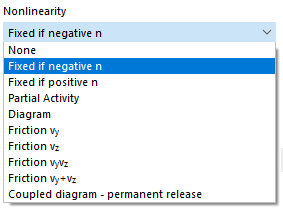For each line release, it is necessary to specify the properties that control the transfer of deformations (and thus of internal forces) between the original line and its copy. This line release type describes the properties of the hinge on the invisible connecting members between the FE nodes of the two lines.
Release Type Conditions
The release type conditions are divided into three 'Translational' degrees of freedom and one 'Rotational' release. The former describe the displacements in the direction of the local axes, the latter controls the rotations about the longitudinal line axis.
To define a release, select the check box for the respective axis. The check mark indicates that an object's displacement in or rotation about the corresponding direction is possible. The constant of the translational or rotational spring is then set to zero. You can adjust the "Spring constant" anytime in order to model an elastic hinge. Enter the spring stiffnesses as design values.
In the 'Nonlinearity' column, you can selectively control the release for each deformation component. Depending on the degree of freedom, suitable entries are available for selection in the list of nonlinearities. For example, you can use the type Friction to simulate static friction effects between two load-bearing components along a line.
Local Axis System
In the list, select the xyz-axis system to which the releases refer:
- Original line
- Member on original line: The axis system of the member assigned to the line is used.
- Z-axis perpendicular to surface: In the list, select the surface whose local z-axis is governing for the alignment of the axes.
- Help node: Enter the number of the node or define it graphically using the
 button. Then, select the plane (x-y or x-z) to define the axes.
button. Then, select the plane (x-y or x-z) to define the axes.
If necessary, you can rotate the line release by an angle β.
.png?mw=760&hash=06aa7bb3e8c871beb171f3607be066e891aabf65)
